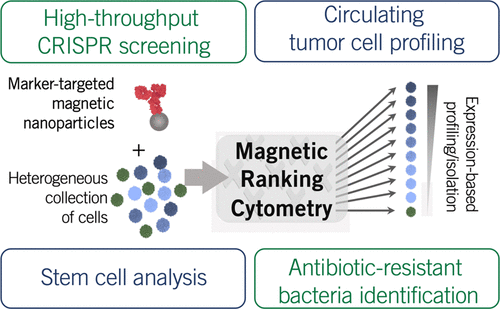当前位置:
X-MOL 学术
›
Acc. Chem. Res.
›
论文详情
Our official English website, www.x-mol.net, welcomes your
feedback! (Note: you will need to create a separate account there.)
Magnetic Ranking Cytometry: Profiling Rare Cells at the Single-Cell Level.
Accounts of Chemical Research ( IF 16.4 ) Pub Date : 2020-07-14 , DOI: 10.1021/acs.accounts.0c00179 Mahmoud Labib 1 , David N Philpott 2 , Zongjie Wang 3 , Carine Nemr 4 , Jenise B Chen 4 , Edward H Sargent 2 , Shana O Kelley 1, 3, 5
Accounts of Chemical Research ( IF 16.4 ) Pub Date : 2020-07-14 , DOI: 10.1021/acs.accounts.0c00179 Mahmoud Labib 1 , David N Philpott 2 , Zongjie Wang 3 , Carine Nemr 4 , Jenise B Chen 4 , Edward H Sargent 2 , Shana O Kelley 1, 3, 5
Affiliation

|
Cellular heterogeneity in biological systems presents major challenges in the diagnosis and treatment of disease and also complicates the deconvolution of complex cellular phenomena. Single-cell analysis methods provide information that is not masked by the intrinsic heterogeneity of the bulk population and can therefore be applied to gain insights into heterogeneity among different cell subpopulations with fine resolution. Over the last 5 years, an explosion in the number of single-cell measurement methods has occurred. However, most of these methods are applicable to pure populations of cultured cells and are not able to handle high levels of phenotypic heterogeneity or a large background of nontarget cells. Microfluidics is an attractive tool for single cell manipulation as it enables individual encasing of single cells, allowing for high-throughput analysis with precise control of the local environment. Our laboratory has developed a new microfluidics-based analytical strategy to meet this unmet need referred to as magnetic ranking cytometry (MagRC). Cells expressing a biomarker of interest are labeled with receptor-coated magnetic nanoparticles and isolated from nontarget cells using a microfluidic device. The device ranks the cells according to the level of bound magnetic nanoparticles, which corresponds to the expression level of a target biomarker. Over the last several years, two generations of MagRC devices have been developed for different applications. The first-generation MagRC devices are powerful tools for the quantitation and analysis of rare cells present in heterogeneous samples, such as circulating tumor cells, stem cells, and pathogenic bacteria. The second-generation MagRC devices are compatible with the efficient recovery of cells sorted on the basis of protein expression and can be used to analyze large populations of cells and perform phenotypic CRISPR screens. To improve analytical precision, newer iterations of the first-generation and second-generation MagRC devices have been integrated with electrochemical sensors and Hall effect sensors, respectively. Both generations of MagRC devices permit the isolation of viable cells, which sets the stage for a wide range of applications, such as generating cell lines from rare cells and in vitro screening for effective therapeutic interventions in cancer patients to realize the promise of personalized medicine. This Account summarizes the development and application of the MagRC and describes a suite of advances that have enabled single-cell tumor cell analysis and monitoring tumor response to therapy, stem cell analysis, and detection of pathogens.
中文翻译:

磁性分级细胞计数法:在单细胞水平分析稀有细胞。
生物系统中的细胞异质性在疾病的诊断和治疗中提出了重大挑战,并使复杂细胞现象的反卷积复杂化。单细胞分析方法提供的信息不会被大批种群的内在异质性所掩盖,因此可用于深入了解具有高分辨率的不同细胞亚群之间的异质性。在过去的五年中,单细胞测量方法的数量激增。但是,这些方法中的大多数都适用于纯培养细胞群体,不能处理高水平的表型异质性或大范围的非靶细胞背景。微流体技术是单细胞处理的一种有吸引力的工具,因为它可以对单个细胞进行单独包裹,可以在对本地环境进行精确控制的情况下进行高通量分析。我们的实验室已经开发出一种新的基于微流体的分析策略,可以满足这种未满足的需求,称为磁等级细胞计数法(MagRC)。表达感兴趣的生物标志物的细胞用受体包被的磁性纳米颗粒标记,并使用微流控设备从非靶细胞中分离出来。该设备根据结合的磁性纳米颗粒的水平对细胞进行排名,这与目标生物标志物的表达水平相对应。在过去的几年中,已经针对不同的应用开发了两代MagRC设备。第一代MagRC设备是用于定量和分析异质样品中存在的稀有细胞(例如循环肿瘤细胞,干细胞和致病细菌)的强大工具。第二代MagRC设备与基于蛋白质表达分类的细胞的高效回收兼容,可用于分析大量细胞并进行表型CRISPR筛选。为了提高分析精度,第一代和第二代MagRC设备的较新版本分别与电化学传感器和霍尔效应传感器集成在一起。两代MagRC设备都可以隔离活细胞,这为广泛的应用奠定了基础,例如从稀有细胞和 第一代和第二代MagRC设备的较新版本分别与电化学传感器和霍尔效应传感器集成在一起。两代MagRC设备都可以隔离活细胞,这为广泛的应用奠定了基础,例如从稀有细胞和 第一代和第二代MagRC设备的较新版本分别与电化学传感器和霍尔效应传感器集成在一起。两代MagRC设备都可以隔离活细胞,这为广泛的应用奠定了基础,例如从稀有细胞和对癌症患者进行有效治疗干预的体外筛选,以实现个性化医学的希望。该报告总结了MagRC的开发和应用,并描述了一系列进展,这些进展使单细胞肿瘤细胞分析和监测肿瘤对治疗,干细胞分析和病原体检测的反应成为可能。
更新日期:2020-08-18
中文翻译:

磁性分级细胞计数法:在单细胞水平分析稀有细胞。
生物系统中的细胞异质性在疾病的诊断和治疗中提出了重大挑战,并使复杂细胞现象的反卷积复杂化。单细胞分析方法提供的信息不会被大批种群的内在异质性所掩盖,因此可用于深入了解具有高分辨率的不同细胞亚群之间的异质性。在过去的五年中,单细胞测量方法的数量激增。但是,这些方法中的大多数都适用于纯培养细胞群体,不能处理高水平的表型异质性或大范围的非靶细胞背景。微流体技术是单细胞处理的一种有吸引力的工具,因为它可以对单个细胞进行单独包裹,可以在对本地环境进行精确控制的情况下进行高通量分析。我们的实验室已经开发出一种新的基于微流体的分析策略,可以满足这种未满足的需求,称为磁等级细胞计数法(MagRC)。表达感兴趣的生物标志物的细胞用受体包被的磁性纳米颗粒标记,并使用微流控设备从非靶细胞中分离出来。该设备根据结合的磁性纳米颗粒的水平对细胞进行排名,这与目标生物标志物的表达水平相对应。在过去的几年中,已经针对不同的应用开发了两代MagRC设备。第一代MagRC设备是用于定量和分析异质样品中存在的稀有细胞(例如循环肿瘤细胞,干细胞和致病细菌)的强大工具。第二代MagRC设备与基于蛋白质表达分类的细胞的高效回收兼容,可用于分析大量细胞并进行表型CRISPR筛选。为了提高分析精度,第一代和第二代MagRC设备的较新版本分别与电化学传感器和霍尔效应传感器集成在一起。两代MagRC设备都可以隔离活细胞,这为广泛的应用奠定了基础,例如从稀有细胞和 第一代和第二代MagRC设备的较新版本分别与电化学传感器和霍尔效应传感器集成在一起。两代MagRC设备都可以隔离活细胞,这为广泛的应用奠定了基础,例如从稀有细胞和 第一代和第二代MagRC设备的较新版本分别与电化学传感器和霍尔效应传感器集成在一起。两代MagRC设备都可以隔离活细胞,这为广泛的应用奠定了基础,例如从稀有细胞和对癌症患者进行有效治疗干预的体外筛选,以实现个性化医学的希望。该报告总结了MagRC的开发和应用,并描述了一系列进展,这些进展使单细胞肿瘤细胞分析和监测肿瘤对治疗,干细胞分析和病原体检测的反应成为可能。











































 京公网安备 11010802027423号
京公网安备 11010802027423号